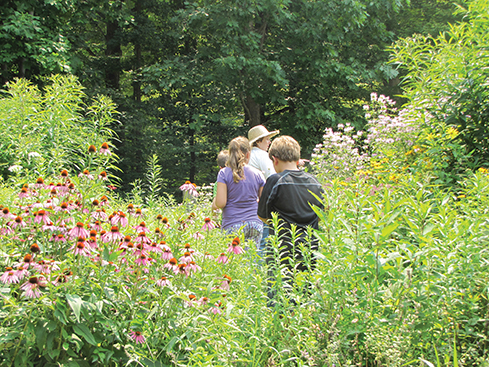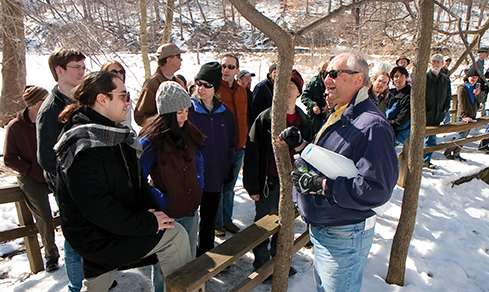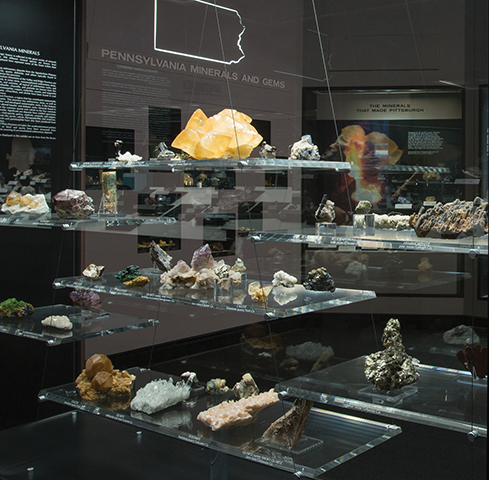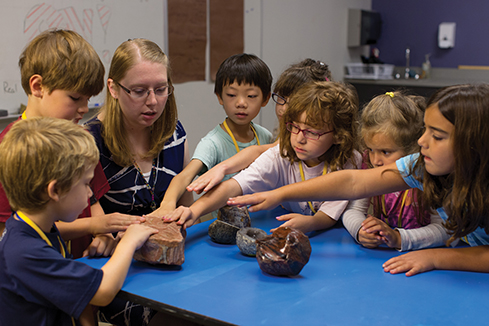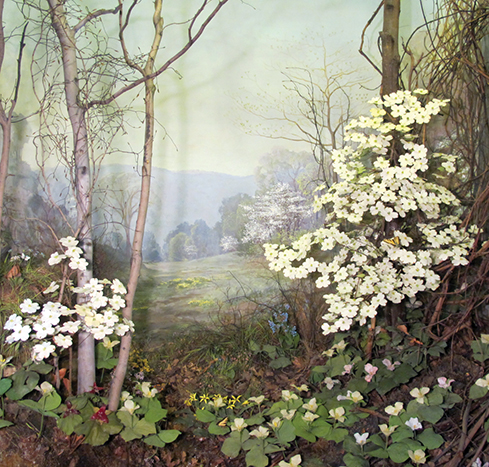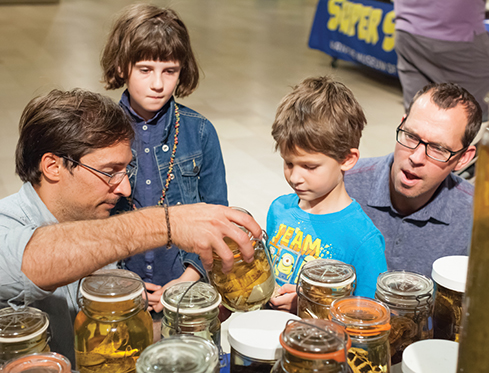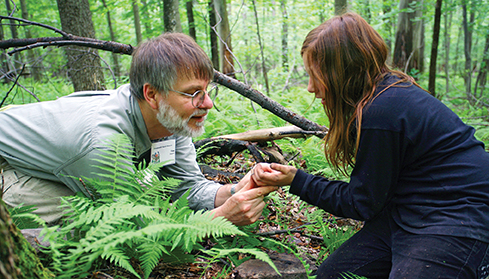 |
|||||||||||||||||
| In ways big and small, Carnegie Museum of Natural History inspires us to dig into the natural history of the place we call home.
Clad in a weatherproof jacket boasting more than its fair share of mud spatters, well-worn work boots, and frayed jeans, geologist Albert Kollar seems undaunted by either the falling temperatures or the falling rain. He’s in his element—literally. From Kollar’s point of view, Schenley Park is a veritable hotbed of western Pennsylvania history. As the scientist in charge of Carnegie Museum of Natural History’s 800,000 invertebrate fossils (animals without a backbone) and rocks, some dating back a billion years, he can often be spotted leading packs of kids and other explorers through the park’s maze of trails.
On this particular Saturday afternoon in March, Kollar finds himself on the Panther Hollow Bridge surrounded by 15 area school teachers who signed up for a continuing education workshop hosted by the museum. The theme for the day is Pennsylvania Natural History, a topic Kollar knows inside and out. But there won’t be any pop quizzes; the goal is for the educators to leave with new lesson plans and activities to share with their own students. “The rocks of Schenley Park record important events in the Earth’s history,” he says. “About 300 million years ago, western Pennsylvania was located near the equator. To the east (or, at that time, the south), the Appalachian Mountains were just being formed and river systems flowed out of the rising mountains into western Pennsylvania, which was a low-lying plain that bordered a large continental seaway.” Kollar then directs their attention to the hollow below; specifically, to the red mudstones that are part of the Pittsburgh red beds, and the Ames Limestone just above them. Rock layer evidence we can observe today helps us envision dramatically different ancient ecosystems, he notes: “These red shales suggest that the climate in western Pennsylvania was warm and dry when the muds were deposited.” What’s more, at one point the entire region was submerged under a warm sea, where tropical creatures lived. It’s the Ames Limestone—which contains more fossils than any other rock layer in the Pittsburgh area—that tips the geologist off to this amazing fact. Fast forward many, many millennia, and it’s clear, Kollar explains, that the climate of the last Ice Age and erosion of the bedrock by water is responsible for the park’s signature hollows and runs of today. As for the city’s mountainous terrain, you can attribute that to the erosion in the bedded rocks that have sat virtually undisturbed for some 250 million years. Unlike other vertically-defined cities (San Francisco, for one, which is still undergoing geologic forces), the formation of Pittsburgh’s hills are, geologically speaking, pretty calm. Meanwhile, back on the bridge, the wind starts to pick up, as does Kollar’s enthusiasm. “Who’s ready for a hike?” he asks.
Exploring the environs of Pittsburgh’s own backyard was a mandate from the moment Andrew Carnegie opened the museum’s doors in 1895. In fact, he saw the adjacent Schenley Park, which had been dedicated just six years earlier, as the perfect natural laboratory. In addition to the age-old stories told by its topography, the park offers real-time insights into the region’s wildlife, including its bird populations, the diversity of its plants and flowers, and the comings and goings of its insects, snails, snakes, frogs, and salamanders. “It’s the biggest show-and-tell in the region. But the best part is that kids get to touch—actually hold in their hands and feel the weight of—an animal horn, feather, turtle shell, or block of coal.”
- PAT MCSHEA, CARNEGIE MUSEUM OF NATURAL HISTORY EDUCATORSince the Museum of Natural History is grounded in western Pennsylvania, it’s not surprising that it dedicates a good deal of its space and time—exhibitions, dioramas, collections, and educational programs, not to mention its ongoing scientific research—to this part of the natural world. “We invite people to explore how the place where we live has changed over time,” says Laurie Giarratani, the museum’s director of education. “The phenomena that shape our familiar Pittsburgh landscape take place on a scale of time that far exceeds our human experience. The study of natural history uncovers clues that open a window into that fascinating past—using observable evidence that we can experience here and now.” THE JOY OF DISCOVERYMany of the museum’s permanent exhibitions offer visitors an opportunity not only to take in the enormity of the past but also consider its ongoing impact on the present. A visit to the Benedum Hall of Geology reveals that the region’s vast quantities of Paleozoic plants on land (preserved as coal) and algae in the sea (preserved as oil and gas) were essentially responsible for sealing Pittsburgh’s fate as the Industrial might of the world—the Steel City. And although the state’s fossil fuel reserves are still driving our way of life, leaving some to question their use for the future, the region also happens to be the resting place for 300 different species of minerals, many of which are on display in the Hillman Hall of Minerals and Gems. Speaking of species, the Hall of North American Wildlife displays 42 of the 70 known species of mammals to dwell within Pennsylvania. No longer a completely hands-off experience, the pelts of a variety of those animals, including the black bear, bobcat, coyote, red fox, spotted skunk, and the official state animal the white-tailed deer, are there for the touching. Dioramas depicting the ecosystems from some of the state’s most valued and beautiful environments— Allegheny Natural Forest, the Laurel Highlands, and Presque Isle, for example—are on view in Botany Hall. “The wonderful thing about these habitats,” Giarratani says, “is the amazing detail they capture, and they’re static snapshots of complex ecosytems,” meaning that any one of them is a prime target for an in-house “bioblitz.” During field trips to the museum, kids—about 25,000 every year—are often dispatched to inventory certain plants, reptiles and amphibians, mammals, insects, fish, birds, and other organisms they observe in habitat dioramas across the museum.
It’s the same technique researchers employ out in the real world to document all living species within a specified area, such as Powdermill Nature Reserve in the Laurel Highlands. The data can then be used to compare and contrast to past bioblitzes and also as a baseline for future surveys. The numbers can speak to the rise or fall of certain flora, fauna, birds, or insects—indicators, perhaps, of a change in the environment that could prompt a nearby farmer to change his crop selection, which could eventually change what food we find on our grocery store shelves. Everything is linked. “We are utterly dependent on this web of life in which we find ourselves,” says the museum’s director of science and research, Steve Tonsor. Making these associations is the museum’s prime mission. “We’re here to connect people to nature,” Giarratani says. “We want them to experience the joy of discovery, to look at our exhibitions and experience the science that goes into them.” Ron Nordstrom, a veteran science teacher at Valley School of Ligonier, has been taking his students to the museum for three decades. “I don’t want to waste a single moment when we’re there,” he says. “I want the kids to soak up everything. They can see from the fossils and rocks how life and our planet have changed over time. They can see the plant and animal diversity in the dioramas and habitats. And they can talk with real-life scientists.” THINKING LIKE A SCIENTISTIt’s no accident that the museum connects visitors with its real-life field explorers as a way to inspire kids and adults alike. “When people visualize scientists they often see them in the lab wearing white lab coats,” Giarratani says, “but museum scientists are just as likely to be out in the field wearing parkas or hiking boots.” They’re also just as likely to be doing things kids do—catching bugs in jars or collecting rocks of all shapes, sizes, and colors. The methods of scientific inquiry really aren’t that mysterious. Take, for example, malacologist Tim Pearce’s snail quest. More than 10 years ago, he set out to create a definitive census of Pennsylvania’s land snails, an important food source for other animals. As Pearce saw it, plants and birds get most of the attention, leaving mollusks to fend for themselves. After reviewing existing museum collections (including Carnegie Museum’s), scanning online databases, and digging around in the dirt, Pearce was able to show where in Pennsylvania the more than 100 recorded species of land snails call home. He recently updated that survey and found that climate change is a potential threat to at least five species, while 49 others are now on the “conservation concern” list, which suggests they’re on the decline. Pearce’s ongoing work has set the pace for the museum’s “Let’s Get Slimy! Science Adventure Class.” According to museum educator Alexandra OBlock, kids follow in Pearce’s footsteps by employing the same scientific methods of observing, measuring, classifying, inferring, and predicting that he does. “We’re here to connect people to nature. We want them to experience the joy of discovery, to look at our exhibitions and experience the science that goes into them.”
- LAURIE GIARRATANI, CARNEGIE MUSEUM OF NATURAL HISTORY DIRECTOR OF EDUCATIONIn order to get kids in a slimy state of mind, educators like OBlock supply third through fifth graders with plastic sandwich bags full of dirt. But this isn’t random dirt; each bag contains soil from various counties within Pennsylvania (there are 67 in all). “We ask the kids to count the number of snail shells they find in each of the bags,” she says. “Then we talk about why certain types of snails are showing up in different places, or why there may be more snails in one region than another.” The answers get them thinking about the natural world and the snail’s place in it. “Fewer snails may indicate something is out of whack,” OBlock says. “Maybe it’s a change in the vegetation or the presence of fungi.” It could, in fact, be the harbinger of bad news, such as the negative effects of acid rain.
The good news, she says, is that “kids are so engaged and have so many questions. That’s how we know we’re doing it right. And besides, snails are just cool.” Snails are just the tip of the iceberg when it comes to cool specimens. Roughly 10,000 objects from the museum’s educational loan collection are available for hands-on exploration at the museum’s first-floor Discovery Basecamp and across the museum’s educational programs. This collection is nearly as old as the institution itself. “The first director thought it was important,” says educator Pat McShea, who has been overseeing the program for 31 years and counting. And that’s as true now as it was then. Originally established as a lending library for local schools, specimens include small objects like minerals, skulls, and feathers as well as taxidermy animals in display cases that range in size from the tiny black-capped chickadee to an impressive wild turkey. McShea organizes the collection thematically, with a special emphasis on Pennsylvania birds, botany, endangered species, and rocks and minerals. Not only do scores of regional teachers now use the collection to help bring their lessons alive, but it’s also the backbone of Discovery Basecamp, a new, 1,900-square-foot gallery devoted to hands-on, interactive learning for all ages featuring real specimens and authentic tools for observation. The new gallery experience combines the historic collection with modern technology such as video microscopes, and creates opportunities for hundreds of thousands of museum visitors to engage with these amazing objects.
“It’s the biggest show-and-tell in the region,” says McShea. “But the best part is that kids get to touch— actually hold in their hands and feel the weight of—an animal horn, feather, turtle shell, or block of coal.” In a way, the museum is like a giant circuit board. And there’s a lot to plug in to: teacher workshops; Natural History on the Move programs that visit schools and hospitals; science adventure classes and summer camps; themed docent-guided tours of the museum’s galleries; and the ever-popular educational loan collection. According to Tonsor, this power-to-the-people approach is essential. After all, the stakes are pretty high. “Only by educating the public,” he says, “can we help them make informed decisions.” Tonsor isn’t an alarmist, but rather a pragmatist who sees a very real need to engage everyone—especially kids— in solving the very real problems facing the planet. Ultimately, he says, it’s the kids studying science in their schools and visiting museums as part of a field trip or family outing who will be better prepared to make some hard choices in the not so distant future. “It’s our sacred responsibility to be good stewards of the planet,” Tonsor adds. “And it starts in our own backyards.”
|
|||||||||||||||||
Ai Weiwei at The Warhol · Window into the Wild · The Adventure Continues · Special Section: Tribute to Our Donors · President's Note · NewsWorthy · Face Time: Eric Dorfman · Artistic License: After Hours · Science & Nature: Teacher's Aide · Travel Log · The Big Picture
 |
Copyright © 2017 CARNEGIE Magazine. All rights reserved. |

